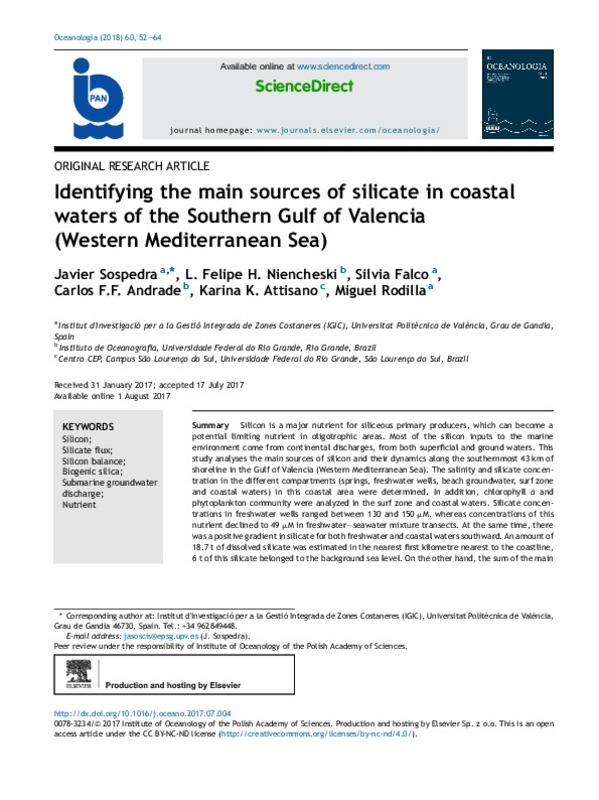JavaScript is disabled for your browser. Some features of this site may not work without it.
Buscar en RiuNet
Listar
Mi cuenta
Estadísticas
Ayuda RiuNet
Admin. UPV
Identifying the main sources of Silicate in coastal waters of the southern Gulf of Valencia (Western Mediterranean Sea)
Mostrar el registro sencillo del ítem
Ficheros en el ítem
| dc.contributor.author | Sospedra, J.
|
es_ES |
| dc.contributor.author | Niencheski, L. Felipe H.
|
es_ES |
| dc.contributor.author | Falco, S.
|
es_ES |
| dc.contributor.author | Andrade, C.F.F.
|
es_ES |
| dc.contributor.author | Attisano, K.K.
|
es_ES |
| dc.contributor.author | Rodilla, M
|
es_ES |
| dc.date.accessioned | 2020-04-27T05:55:16Z | |
| dc.date.available | 2020-04-27T05:55:16Z | |
| dc.date.issued | 2018 | es_ES |
| dc.identifier.issn | 0078-3234 | es_ES |
| dc.identifier.uri | http://hdl.handle.net/10251/141516 | |
| dc.description.abstract | [EN] Silicon is a major nutrient for siliceous primary producers, which can become a potential limiting nutrient in oligotrophic areas. Most of the silicon inputs to the marine environment come from continental discharges, from both superficial and ground waters. This study analyses the main sources of silicon and their dynamics along the southernmost 43 km of shoreline in the Gulf of Valencia (Western Mediterranean Sea). The salinity and silicate concentration in the different compartments (springs, freshwater wells, beach groundwater, surf zone and coastal waters) in this coastal area were determined. In addition, chlorophyll a and phytoplankton community were analyzed in the surf zone and coastal waters. Silicate concentrations in freshwater wells ranged between 130 and 150 mu M, whereas concentrations of this nutrient declined to 49 mu M in freshwater-seawater mixture transects. At the same time, there was a positive gradient in silicate for both freshwater and coastal waters southward. An amount of 18.7 t of dissolved silicate was estimated in the nearest first kilometre nearest to the coastline, 6 t of this silicate belonged to the background sea level. On the other hand, the sum of the main rivers in the area supplies 1.6 t of dissolved silicate per day. This implies that a large amount of the remaining 11.1 t must derive from submarine groundwater discharges, which would thus represent 59% of the coastal dissolved silicate budget. Overall, it is suggested that a subterranean transport pathway must contribute considerably to silicate concentrations throughout this zone, which is characterized as permeable. (c) 2017 Institute of Oceanology of the Polish Academy of Sciences. Production and hosting by Elsevier Sp. z o.o. | es_ES |
| dc.description.sponsorship | The authors acknowledge the financial support for this study from the CNPq (Brazil - Grant 303672/2013-7). We are very grateful for the valuable comments of anonymous reviewers on previous versions of the manuscript. | es_ES |
| dc.language | Inglés | es_ES |
| dc.publisher | Elsevier | es_ES |
| dc.relation.ispartof | Oceanologia | es_ES |
| dc.rights | Reconocimiento - No comercial - Sin obra derivada (by-nc-nd) | es_ES |
| dc.subject | Silicon | es_ES |
| dc.subject | Silicate flux | es_ES |
| dc.subject | Silicon balance | es_ES |
| dc.subject | Biogenic silica | es_ES |
| dc.subject | Submarine groundwater discharge | es_ES |
| dc.subject | Nutrient | es_ES |
| dc.subject.classification | TECNOLOGIA DEL MEDIO AMBIENTE | es_ES |
| dc.title | Identifying the main sources of Silicate in coastal waters of the southern Gulf of Valencia (Western Mediterranean Sea) | es_ES |
| dc.type | Artículo | es_ES |
| dc.identifier.doi | 10.1016/j.oceano.2017.07.004 | es_ES |
| dc.relation.projectID | info:eu-repo/grantAgreement/CNPq//303672%2F2013-7/ | es_ES |
| dc.rights.accessRights | Abierto | es_ES |
| dc.contributor.affiliation | Universitat Politècnica de València. Departamento de Ingeniería Hidráulica y Medio Ambiente - Departament d'Enginyeria Hidràulica i Medi Ambient | es_ES |
| dc.description.bibliographicCitation | Sospedra, J.; Niencheski, LFH.; Falco, S.; Andrade, C.; Attisano, K.; Rodilla, M. (2018). Identifying the main sources of Silicate in coastal waters of the southern Gulf of Valencia (Western Mediterranean Sea). Oceanologia. 60(1):52-64. https://doi.org/10.1016/j.oceano.2017.07.004 | es_ES |
| dc.description.accrualMethod | S | es_ES |
| dc.relation.publisherversion | https://dx.doi.org/10.1016/j.oceano.2017.07.004 | es_ES |
| dc.description.upvformatpinicio | 52 | es_ES |
| dc.description.upvformatpfin | 64 | es_ES |
| dc.type.version | info:eu-repo/semantics/publishedVersion | es_ES |
| dc.description.volume | 60 | es_ES |
| dc.description.issue | 1 | es_ES |
| dc.relation.pasarela | S\348273 | es_ES |
| dc.contributor.funder | Conselho Nacional de Desenvolvimento Científico e Tecnológico, Brasil | es_ES |








